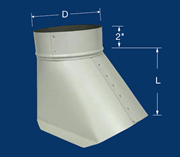I see dust collection pictures on here all the time and I'm finally about to do my DC in my shop. What is the silver ducting that I see used alot and how good is it? Is it HVAC and if so, is there a certain name for it? I know PVC has different thicknesses and all, is there a certain thickness of this pipe and is it more cost effective than PVC?





 Reply With Quote
Reply With Quote











